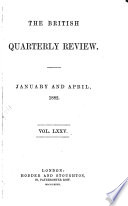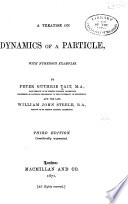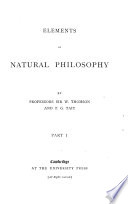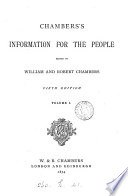 | 1882 - 662 pages
...conditions. 3rd. Commencement or change of motion is proportional to the disturbing force, less the resisting force ; and takes place in the direction of the straight line in which the two forces act and react. I commenced this brief article by disclaiming all interest in the merely... | |
 | Peter Guthrie Tait - 1865 - 394 pages
...illustrate by referring to small and trivial cases as well as to the grandest phenomena we can conceive. 60. LAW II. Change of motion is proportional to the impressed...direction of the straight line in which the force acts. We have considered change of velocity, or acceleration, as a purely geometrical quantity, and... | |
 | Isaac Todhunter - 1867 - 368 pages
...the Second Law of Motion. 45. Second Law of Motion. Change of motion is proportional to the acting force, and takes place in the direction of the straight line in which the force acts. So long as we keep to the same force and the same body change of motion is measured by change... | |
 | Isaac Todhunter - 1867 - 372 pages
...compelled to change that state by force acting on it. II. Change of motion is proportional to the acting force,, and takes place in the direction of the straight line in which the force acts. III. To every action there is always an equal and contrary reaction: or the mutual actions of... | |
 | William Thomson Baron Kelvin, Peter Guthrie Tait - 1867 - 914 pages
...rw i//n imprimitur. Change of motion is proportional to the imvrt'.wd fu/rc, and 1 1 , second law. takes place in the direction of the straight line in which the force <'<-(&. 252. If any force generates motion, a double force will generate double motion, and so on,... | |
 | Class-book - 1868 - 330 pages
...of Motion, which is "That every change of motion is proportional to the force producing the change, and takes place in the direction of the straight line in which the force acts." 12. Q. How is it that a half-open- door, which a slight touch Kould disturb, may be pierced... | |
 | Peter Guthrie Tait, William John Steele - 1871 - 462 pages
...illustrate by referring to small and trivial cases as well as to the grandest phenomena we can conceive. 65. LAW II. Change of motion is proportional to the impressed...force, and takes place in the direction of the straight ''ne in which the force acts. We have considered change of velocity, or acceleration, as a purely geometrical... | |
 | William Thomson Baron Kelvin, Peter Guthrie Tait - 1872 - 316 pages
...proportionalem esse vi motrici impressae, et fieri secundum lineam rectam qud vis ilia imprimitur. Change of motion is proportional to the impressed...direction of the straight line in which the force acts. 218. If any force generates motion, a double force will generate double motion, and so on, whether... | |
 | Chambers W. and R., ltd - 1874 - 848 pages
...line, except in so far as it may be compelled to change that state by forces impressed upon it. id. Change of motion is proportional to the impressed...direction of the straight line in which the force is impressed. 3</. To every action there is always an equal and contrary reaction ; or the actions... | |
 | Thomas Minchin Goodeve - 1874 - 340 pages
...we pass on to examine the exact relation between force and the motion which it produces. Second Law. Change of motion is proportional to the impressed...direction of the straight line in which the force is impressed. Hitherto it has been sufficient to speak of the motion of bodies, without regarding this... | |
| |